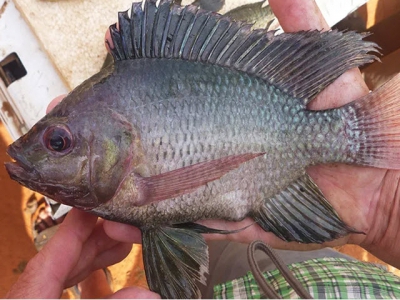Concerns over tilapia biodiversity

A new study has revealed the scale of hybridization taking place between native and introduced tilapia in Tanzania.
Escaped Nile tilapia are cross-breeding with local varieties, posing a threat to biodiversity and the growth rates of farmed fish. Photo: Prof Martin Genner
According to the authors, cross-breeding between escaped farmed tilapia and their wild cousins is having negative effects on both biodiversity and aquaculture production. In particular, they say that the hybridisation is threatening the status of a unique population of native tilapia, while also risking the occurrence of stunting in farmed populations.
Cross-breeding, they note, can harm both biodiversity and the yield of fish farms, a vital source of food and economic stability. The researchers - from the University of Bristol, the University of Roehampton, Bangor University, the Tanzania Fisheries Research Institute (TAFIRI) and the Earlham Institute - are now developing genetic resources to quickly identify the issue in fish populations so that action can be taken.
Nile tilapia (Oreochromis niloticus) are farmed in many parts of the tropics, due to their fast growth and high tolerance to a range of environmental conditions, but these traits also mean they can outcompete native species in areas where they are introduced. Local varieties of tilapia, such as Oreochromis korogwe, which was known to live in the north of Tanzania but has only recently been identified in lakes in the south of the country, are now at risk.
Recent papers from the same research group show that invasive Nile tilapia have hybridized with other native species in Tanzania. The capture of O. korogwe specimens that seem to share features from both native and farmed tilapia has confirmed these fears and raised alarm bells amongst the researchers.
“Because we already knew that the Nile tilapia had the potential to breed with native species, we wondered whether this might present a problem,” said Dr Adam Ciezarek of the Haerty Group at Earlham Institute. “Native fish can often be adapted to very specific local environments, adaptation which might break down through cross-breeding with invasive tilapia.”
A genetic analysis using microsatellites revealed that these fish were indeed hybrids, but whole genome sequencing of different populations of O. korogwe in the north and south of Tanzania revealed something quite unexpected.
“As well as looking at the recent hybrids, we wanted to look at the genomes of the other fish,” said Ciezarek. “We saw that all the O. korogwe we investigated from the lakes in the south of Tanzania, even those that don’t look like hybrids, have some Nile tilapia DNA in their genome.”
Interestingly, evidence of this mixing of genetic material was not present in O. korogwe from the North of Tanzania.
“You would expect the two populations of O. korogwe to be most similar to each other,” said Ciezarek. “But there are quite large parts of the genome where the southern O. korogwe and the Nile tilapia are the most closely related to each other, which suggests there has been fairly recent gene flow between them. These are quite long stretches of DNA - about half of one chromosome seems to have been introduced from Nile tilapia into the southern O. korogwe.”

One of the lakes where the sampling took place. Photo: Prof Martin Genner
Tanzania is home to thirteen unique species of tilapia, including O. korogwe. The differences between O. korogwe in the north and south of Tanzania highlight one of the great points of concern for local biodiversity, whereby unique populations of fish that are only just being discovered are already threatened.
“We identified unique populations of fish that are distinct from other populations,” says Dr Antonia Ford of the University of Roehampton. “Already as we’re describing that new biodiversity, we’re finding it’s hybridizing with introduced species. It’s as if it’s already being lost before we even knew it was there.”
Hybridization can also have a negative impact on local fish farms. Accidentally introduced hybrid fish can breed with the specially-bred farm varieties, which over several generations leads to stunting and a reduction in yields. This can cause ponds to lose economic viability, the researchers note.
It’s therefore important for both farmers and biodiversity to detect, and prevent, such hybridization events, say the researchers. And the team is now developing genetic resources to help breeders and conservationists detect hybridization, even in juvenile fish where hybrids are more difficult to identify compared with adults.
“In the long-run, we hope that our work will help inform conservation and management of indigenous tilapia species in Africa, through interventions that benefit both the natural environment and people,” says Professor Martin Genner of the University of Bristol.
“An important next step will be to build a more complete understanding of the combined ecological, social and economic factors underlying the impact of invasive species, and this will enable measures to be identified and implemented that equally promote biodiversity conservation and food security.”
Related news
 Common diseases of pangasius catfish farmed in Vietnam
Common diseases of pangasius catfish farmed in Vietnam The freshwater catfish (Pangasius hypophthalmus) is an indigenous fish species in high demand from global consumers.
 The aquatic chicken - tilapia genetics and their parallels with poultry
The aquatic chicken - tilapia genetics and their parallels with poultry When considering ongoing genetic improvement efforts in tilapia culture, comparisons with the development of the modern chicken industry often present themselve
 New treatment strategy for amoebic gill disease could revolutionise parasitic treatment
New treatment strategy for amoebic gill disease could revolutionise parasitic treatment New treatment strategy for amoebic gill disease could revolutionise parasitic treatment in humans